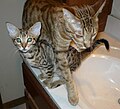| Ocicat | |
|---|---|
 Lilac spotted tabby Ocicat | |
| Origin | United States |
| Breed standards | |
| CFA | standard |
| FIFe | standard |
| TICA | standard |
| ACFA/CAA | standard |
| CCA-AFC | standard |
| GCCF | standard |
| Notes | |
Slightly larger than regular domestic cats. | |
| Domestic cat (Felis catus) | |
The Ocicat is an all-domestic breed of cat which resembles a wild cat but has no recent wild DNA in its gene pool. It is named for its resemblance to the ocelot. The breed was established from the Siamese and Abyssinian and later on American Shorthair would be added.








